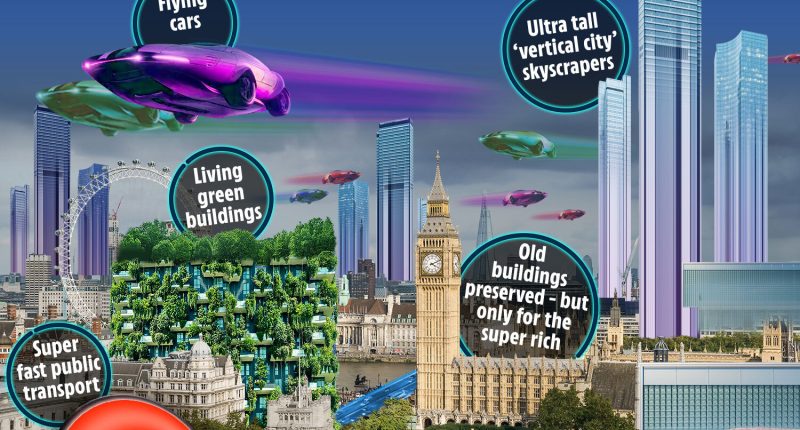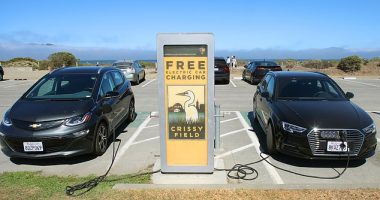WITH flying cars, hyperloops and giant skyscrapers – this is a vision of how London could look in 2100.
Rain-drinking towers, “living” buildings and driverless roads could all see the capital nearly unrecognisable in the next 80 years.
The Sun spoke to experts and futurists who painted us an incredible – and supposedly realistic – vision of the future.
The vision shows a city which has completely changed its transport networks and is dominated by enormous tower blocks.
Starting at ground level, London’s traffic-snarled roads with black cabs and red buses could become entirely self-driving.
Increasingly advanced technology would mean people no longer need to be behind the wheel – instead trusting themselves to a computer.
READ MORE ON THE FUTURE
Cars as we know them now are likely to be a mere memory as residents are ferried around by self-driving motors – but not just on the roads.
That’s right, experts firmly believe we are set to see the introduction of flying cars – with new road networks darting between 2100 London’s tower cityscape.
With limited space on London roads, vehicle owners are likely to take to the skies in an attempt to reach their destination without the inconvenience of traffic.
As for public transport, the terrifying yet life-changing hyperloop concept could finally be in use.
Most read in Tech
It would take people in and out of London and across the country in a flash.
The hyperloop uses low-pressure sealed tubs which essentially suck pods full of people – or cargo – from point A to point B.
It could become such a game-changer that people have the luxury of living in one city and working in another due to the ultraquick journey times – cutting out the grinding morning commute.
Some Hyperloops have been predicted to go as fast as 700mph.
That means you could get from London’s easterly most point to its westerly other in just 3 minutes.
Elon Musk is just one tech chief who loves the concept – and while we haven’t seen a working network yet in 2024, by 2100 it could be the norm.
Perhaps the famous London Underground blue and red roundel will one day say: “Hyperloop”.
We could see Hyperloop used to connect London to other major UK cities
Maria Opre
But it isn’t just vehicles and transport that will see major advancements by the time 2100 is here, according to futurists.
London’s landscape is also expected to transform dramatically by the turn of the next century.
Vertical city skyscrapers are expected to be the most obvious change to the city, with a lack of space at ground level meaning the only way to build is up.
The increasing population – with the UK expected to be home to 80million people by the turn of the next century – will contribute to the need for these megastructures.
Plenty of artists have already drawn up futuristic scenarios of how London may look in just over 75 years, with a noticeable increase in skyscrapers and buildings that give off electric glows.
But while no one truly knows how London will look by the time 2100 rolls around, one expert told us the British capital will become an “electricity-driven vertical city”.
Architect and interior designer Jo Chrobak told The Sun: “There will be a huge divide between the old and the new,”
“The old buildings will be preserved relics, but only for the rich because these are the people who can afford the maintenance and upkeep of these historic homes.
“The majority will live in high-rise, electricity-driven vertical cities.”
Technological innovations are also expected to be huge in London’s layout.
According to EarthWeb senior analyst Maria Opre, who predicts how major cities may change as technology advances, London could transform “tremendously”.
She told The Sun: “Sensors everywhere will allow higher degrees of automation, integration, and efficiency in many sectors.
“Networks of self-driving electric vehicles could fix traffic and emissions problems while improving access for all.
“Through long-range preparation, strong administration, and cautious reliance on technology, population centres may maintain secure, sustainable, and good living conditions.”
Maria also predicted that improvements in technology will also make the city more eco-friendly – with more powerful solar panels now gathering energy from the sun.
And the way buildings are constructed will also likely change in the next century.
“For example, advanced building materials like environmentally friendly concrete and recycled steel may replace traditional choices,” she explained.
Maria added futurists believe city buildings will also be increasingly built of “prefabricated” parts rather than traditional techniques – allowing them to pop up quickly.
Biggest technological advances by 2100

It’s anyone’s guess as to how London will look in 75 years’ time, but it isn’t just the capital where things will change.
Here are some of the biggest technological advances that could take place between now and 2100 across the UK.
Digital Humans
AI is already making waves in the current world but robots and humanoids could well become an integrated part of our population by the turn of the next century.
Underground cities
It’s not been done yet but could underground cities become the next stage of construction if we run out of room on the surface?
Virtual schools
The Covid-19 pandemic saw the introduction of remote learning and doing everything online, but things could be taken one step further for kids at school with the introduction of AI mentors in place of teachers.
Digital knowledge
By 2100, humans could be able to directly connect their brains to the internet and download information directly to their heads.
Force fields
War is ripe in 2024 but with fears it could soon become even worse, we could see the introduction of near-impenetrable force fields that deflect damage from bullets, missiles and more.
University of Lancaster scientist Serena Pollastri previously outlined predictions for the future of Britain’s big towns, including the removal of all cars from our roads by 2100.
She also claimed that much more efficient, reliable and accessible public transport could replace most cars and carry workers to their offices in skyscrapers that absorb rainfall.
And at the centre of this is the so-far anti-climatic, but much anticipated, Hyperloop.
“The Tube may not be entirely replaced by a Hyperloop system, but we could see Hyperloop used to connect London to other major UK cities,” said Maria.
“The Tube network is so expansive that fully replacing it doesn’t seem feasible.
“However, we could see Hyperloop used for certain busy routes to increase capacity and speed.”
But the solution is to look to the skies, according to Irish SpaceX Hyperloop pod competition team, Éirloop.
They predicted that humans will be “driving in the sky” where far more space can be found than on roads or underground.
By 2100, fleets of flying taxis could transport passengers across London skies
Maria Opre
But visualisations of a driverless car-filled London, where people work or relax in sleek vehicles with picturesque views of a city void of traffic, accidents, or even rain, have also been proposed.
But the introduction of driverless cars, or the complete removal of road vehicles altogether, would have a huge impact on one of the most unique things about London – its black cabs.
There remains hope, however, that they won’t disappear entirely.
“Flying taxis are a real possibility,” said Maria.
“Companies like Lilium are already developing electric vertical take-off and landing aircraft for urban transportation.
“By 2100, fleets of flying taxis could transport passengers across London skies.
“Black cabs won’t go away entirely, but will become less prevalent.”
London could also end up looking a lot greener – with skyscrapers covered with a think external layer of foliage.
READ MORE SUN STORIES
And with the advent of flying cars, super-fast transport, and a nearly automated road system – some car parks and roads could be changed into green corridors.
More forests and parks could spring up around the city – truly making the British capital a green and pleasant land.













